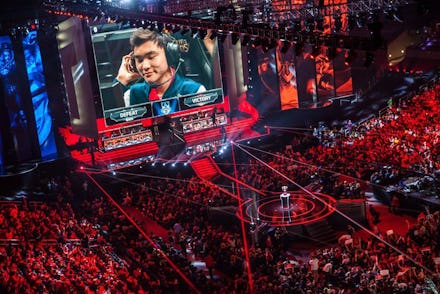Why Pro Video Games Are The Future of Televised Sports

What's one thing Taylor Swift, Wrestlemania, and the video game League of Legends have in common? They've all sold out the infamous Staples Center in less than an hour. While the first two may come as no surprise, the ability of a video game to sell out a venue that can seat nearly 20,000 people is quite a shocker. Yet the popularity of video game events — and especially of eSports — is on the rise, even surpassing some mainstays of traditional live and broadcast programming. The Rolling Stones failed to sell out the Staples Center earlier this year. Professional baseball hasn't seen a prolonged a growth in viewership since 1978. The 2012 world series had the lowest rating in the history of televised baseball, and preliminary 2013 ratings show similar numbers. Although eSports have yet to achieve the same popularity, it's starting to seem, from online viewership, that televised video games could eventually reach a mass audience. This would leave the old stereotypes about video games and gamers in the dust. Yet networks are hesitant to capitalize on the trend.
The percentage of overall growth in viewership of eSports, especially, has dwarfed nearly all other sporting events in the United States and continues to climb at staggering levels. The IGN Pro League saw a 951% growth in viewership between 2011 and 2012 for their flagship event, drawing over 6 million unique viewers through platforms like Twitch TV, YouTube, Xbox LIVE, and more. Some TV networks maintain that the content is too niche for their mainstream audience and that it wouldn't succeed on primetime television. What they don't realize is that this niche audience is becoming increasingly large and moving to the mainstream.
If six million separate individuals are willing to navigate dubious online ads and spam to watch people play a video game, there can be no denying that there would be more who would inevitably tune-in to watch on a much larger screen from the comfort of their couch. Would it be enough of a push to surpass the 12 million viewers that tuned in to the 2012 World Series? Probably not. Is it mildly ridiculous that the top earners of the live gaming industry bring in over $400,000 a year to play video games? Maybe. To further aggravate the skeptics of eSports, the United States is now officially recognizing professional gamers as professional athletes and granting P-1A visas in order to practice and compete with their teammates — the very same visa they grant for traveling athletes in the NFL, NBA, MLB, and other leagues. With all of the growing legal support why are the major networks still hesitant take a chance on eSports?
Ultimately, the barrier to broadcast video games isn't the question of whether anyone would watch, but rather a question of image and status. If you're a millennial who went to grade school sometime in the 90s, then you'll understand why people call themselves "Closet Nerds." People were ridiculed, laughed at, and in many cases became pariahs of a social community where gamers were the lowest-of-the-low. Gamers everywhere should cheer and applaud the growth that's been made by society in its acceptance of gaming culture over the last 20 years. But applause hasn't been enough yet to counteract old stigmas.
World of Warcraft may have been cited in 2008 by the FCC as one of the top reasons for college drop-outs in the US, and there may be adults living with their parents playing video games 12-18 hours a day. But are these travesties of gaming so much less forgivable than the football stars who inflict so much off-the-field trauma on our society and are consistently forgiven? Gaming culture has been historically judged on the rare, yet mostly negative, press it has received. Only recently have staunch enthusiasts finally developed enough courage and pride in their pastime to push it closer to the forefront of our society.
Children play video games. Parents play video games. Grandparents play video games. Our society is in a unique and historic time in that video games span all generations of people and, as of now, television networks are missing out on a shot at the multi-billion dollar pie that is the video game industry. If events like the World Series can score a primetime spot with 13 million viewers — a mere 13% of the 108 million that the 2013 Super Bowl scored — one can assume that someone will eventually realize the untapped potential the video game industry has to reach similar heights. Until then, gamers who wish to partake in the intense fandom that is "eSports" will have to remain where they are: in front of their computers.